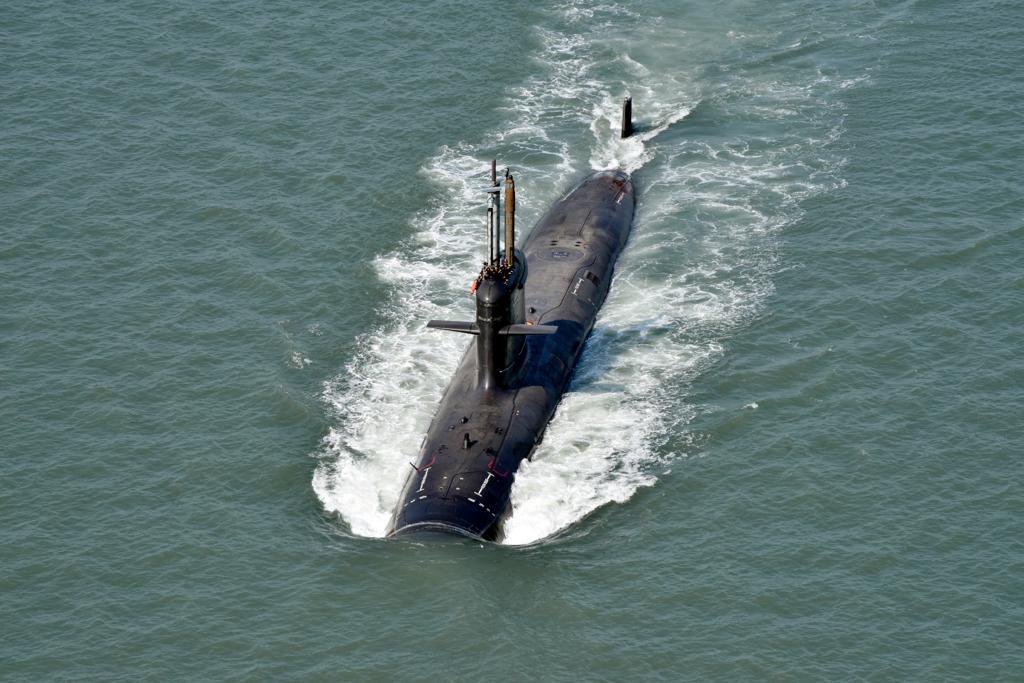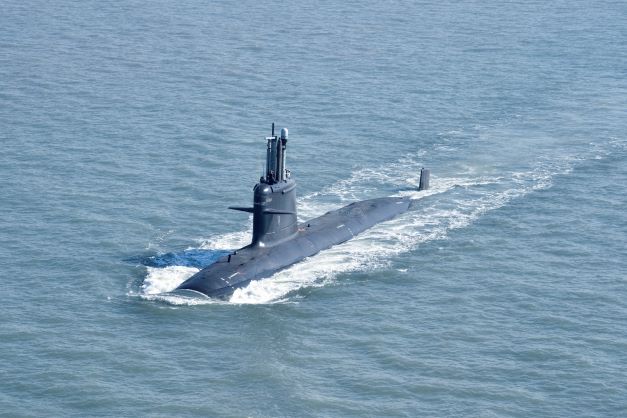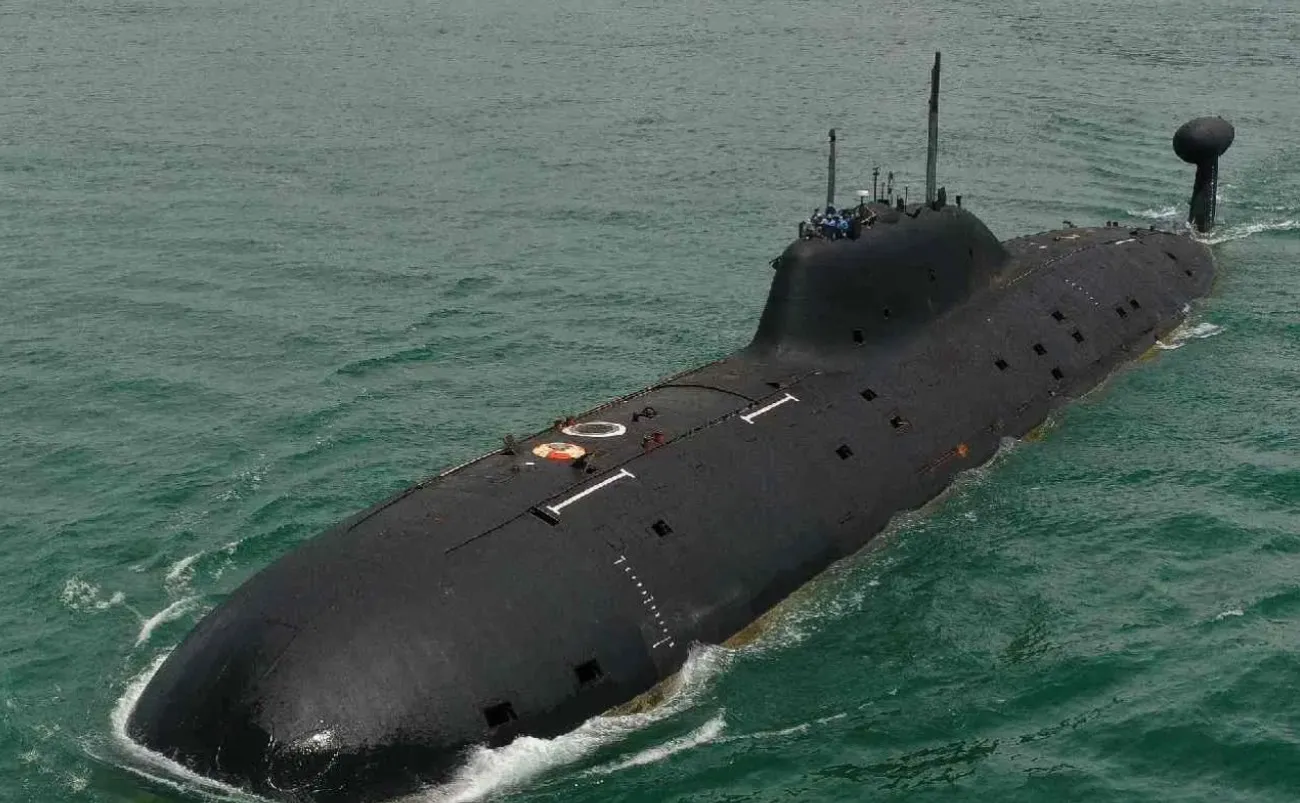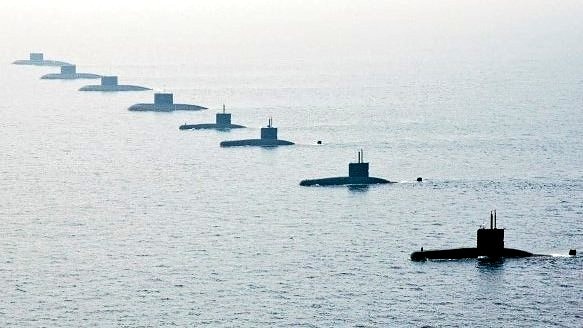India’s Submarine Strategy in Crisis: Delays Sink Naval Ambitions as Pakistan-China Axis Surges Underwater
Originally launched in 1999, the plan aimed to deliver 24 state-of-the-art submarines by 2030, including six nuclear-powered attack submarines (SSNs), to establish decisive undersea dominance across the Indian Ocean Region (IOR).
(DEFENCE SECURITY ASIA) — More than two decades after the Indian Navy unveiled its highly ambitious 30-year submarine building strategy, the program is now a case study in strategic delay and defence procurement dysfunction.
Originally launched in 1999, the plan aimed to deliver 24 state-of-the-art submarines by 2030, including six nuclear-powered attack submarines (SSNs), to establish decisive undersea dominance across the Indian Ocean Region (IOR).
Today, with the program approaching its theoretical conclusion, India’s undersea warfare ambitions remain dangerously unfulfilled.
Only six Scorpene-class submarines have been constructed under Project-75, all with significant French technological assistance.
The final vessel in the class, INS Vagsheer, was inducted in January 2025, arriving late and emblematic of the persistent timeline slippage that has marred the initiative.
As of mid-2025, the Indian Navy operates just 19 submarines—16 conventional diesel-electric units and two indigenously constructed SSBNs (nuclear-powered ballistic missile submarines).
The Indian Navy’s lease of the Russian Akula-class nuclear-powered attack submarine concluded in 2021, leaving the fleet without any operational SSNs.

Although discussions were underway to lease another Akula-class platform from Russia, the outbreak of the Ukraine conflict and the subsequent imposition of global sanctions effectively derailed those plans.
The overwhelming majority of these conventional submarines are over 30 years old, placing severe limitations on their combat survivability, endurance, and stealth in a modern maritime battlespace increasingly dominated by AIP-equipped and network-centric adversaries.
The original doctrine envisioned a phased progression: initial foreign collaboration would eventually give way to a fully indigenous submarine manufacturing ecosystem, reducing reliance on imports and enhancing national defence self-sufficiency.
However, the reality has been defined by bureaucratic inertia, complex procurement bottlenecks, recurring cost escalations, and a lack of consistent political urgency.
Project-75I, the second phase of the grand strategy that seeks to add six advanced AIP (air-independent propulsion) submarines, remains mired in indecision despite its strategic necessity.
The AIP-equipped submarines under P-75I are intended to operate far from Indian shores for prolonged durations without surfacing, enhancing survivability in high-threat environments and enabling persistent sea denial operations.
Though Mazagon Dock Shipbuilders Ltd (MDL) was invited in January 2025 to begin price negotiations for this mega-contract—estimated at approximately ₹70,000 crore or USD 8.4 billion (RM39.5 billion)—progress has since stagnated.
MDL’s proposal, supported by Germany’s ThyssenKrupp Marine Systems (TKMS), remains the only active bid after Larsen & Toubro’s (L&T) offer, in partnership with Spain’s Navantia, was disqualified for technical non-compliance.

The defence ministry opened commercial bids in January 2025, following the receipt of field evaluation trial results in July 2024, yet no subsequent invitation for final negotiation has been extended to MDL.
Originally estimated at USD 5.1 billion (RM24.3 billion) a decade ago, the deal’s price tag has ballooned due to inflationary pressures, foreign exchange volatility, and expanding technical requirements, making it the most expensive defence acquisition in Indian history.
Officials familiar with the matter claim the Ministry of Defence’s silence following the bid opening has raised industry-wide concerns about procedural uncertainty and transparency.
Navantia, which previously contributed to India’s submarine capability development, insists its third-generation AIP technology will be sea-proven by 2027 and has pledged deep technology transfers—an offer aligned with India’s broader “Atmanirbhar Bharat” doctrine.
L&T has submitted formal objections over its exclusion and that of Navantia, emphasizing that the Navy assessed their AIP solution on a land-based prototype while accepting Germany’s sea-proven design.
This has sparked calls for both MDL and L&T to be invited for final cost negotiations, with defence officials arguing that such an approach would break the looming single-vendor impasse and enhance India’s bargaining leverage.
While New Delhi’s submarine program flounders, Islamabad is rapidly closing the undersea capability gap—with strategic backing from Beijing.
In April 2025, Pakistan received its second Hangor-class submarine from China, a crucial milestone in an ongoing $5 billion (RM26.5 billion) agreement for eight advanced AIP-equipped boats.

These Hangor-class submarines are integrated with modern weaponry, combat management suites, sonar systems, and endurance enhancements that provide strategic punch for Pakistan’s sea denial doctrine.
All eight submarines are expected to be delivered over the next decade, providing Pakistan with a fresh, highly capable submarine force likely to outmatch India’s legacy platforms in underwater endurance and lethality.
This comes on top of the recent induction of four Chinese Type 054A/P frigates into the Pakistan Navy, reinforcing the Sino-Pakistani maritime axis and challenging India’s assumed dominance in the Arabian Sea.
China’s active support for Pakistan’s naval buildup directly aligns with Beijing’s expanding geopolitical footprint across the Indian Ocean and the establishment of dual-use infrastructure such as Gwadar port in Balochistan.
These developments reinforce China’s strategy of encircling India with a multi-layered naval presence, using economic, political, and military levers to exert influence across key maritime chokepoints.
China is projected to maintain a submarine fleet of 65 boats by the end of 2025, with that number expected to rise to 80 by 2035, according to global defence estimates.
India’s inability to operationalize its own SSN fleet, let alone ramp up indigenous diesel-electric production, leaves it vulnerable in key maritime corridors such as the Malacca Strait, Andaman Sea, and the greater IOR.
SSNs provide unmatched operational endurance and strategic flexibility, enabling covert long-range surveillance, anti-submarine warfare dominance, and rapid-response power projection—capabilities India sorely lacks in its current force structure.


